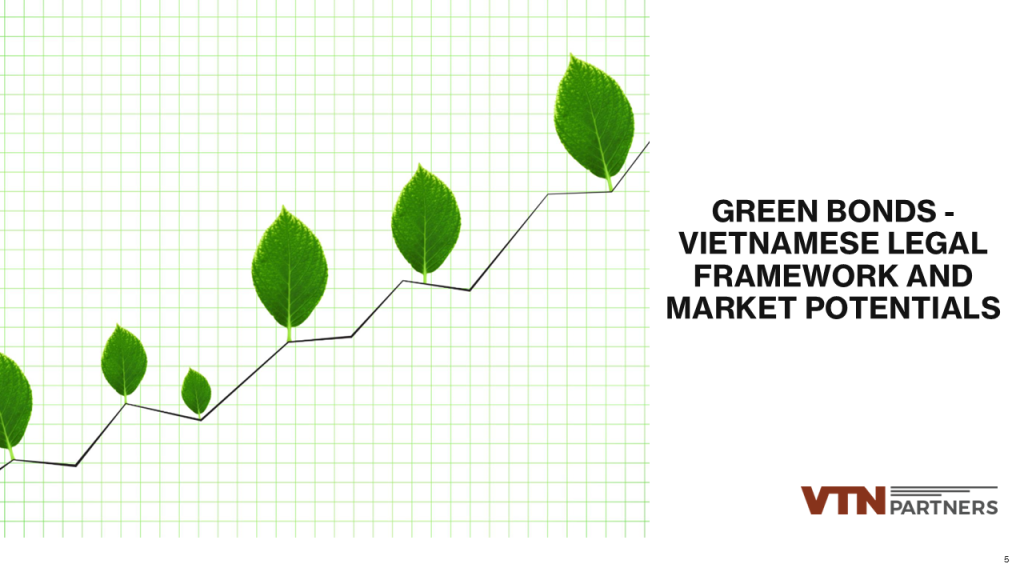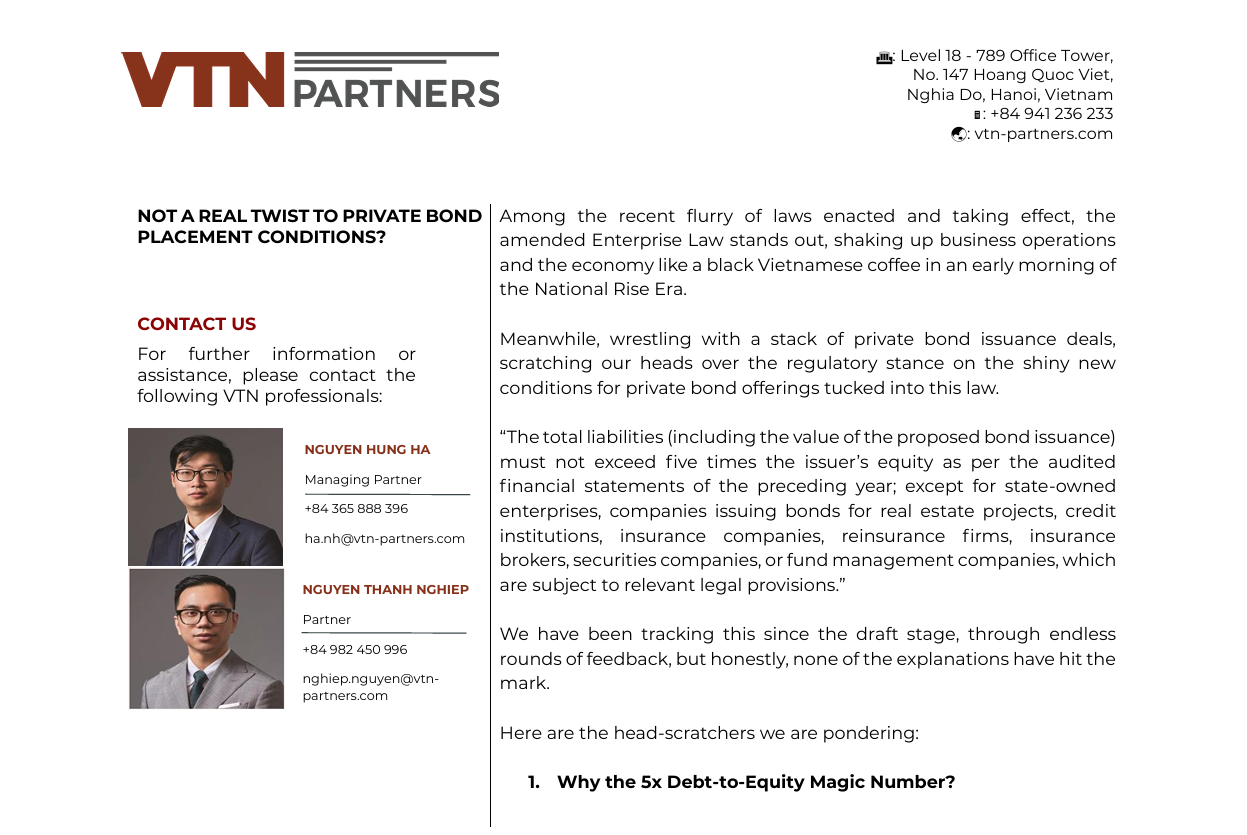The global green bond market has grown substantially, with cumulative issuance reaching approximately USD 2.8 trillion by the end of 2023. Vietnam’s participation remains modest but growing. The year 2024 witnessed significant growth with VND 6.9 trillion in green bond issuances, representing a 171 percent increase from the previous year, though this comprised only 1.5 percent of total corporate bond issuances.
Green bonds have emerged as critical instruments for mobilizing capital toward environmentally sustainable projects globally. Vietnam, committed to achieving net-zero emissions by 2050, has established a legal framework for green bond issuance. This article examines the legal architecture governing green bonds under Vietnamese law, evaluates its alignment with international standards, and assesses the market outlook.
Green Bond Initiatives – International Practice
The International Capital Market Association (ICMA) Green Bond Principles (GBP), first published in 2014, establish voluntary process guidelines with four core components: (i) Use of Proceeds, (ii) Process for Project Evaluation and Selection, (iii) Management of Proceeds, and (iv) Reporting. These principles form the foundation for most international green bond frameworks.
The ASEAN Green Bond Standards, developed by the ASEAN Capital Markets Forum in collaboration with ICMA, provide region-specific guidance. While aligned with the GBP, the ASEAN Standards mandate annual reporting on allocation and environmental impact, whereas ICMA Principles only recommend such disclosures. The ASEAN Standards also provide more specific guidance to facilitate labeling of bonds as “ASEAN Green Bonds,” promoting consistency across member states.
The Climate Bonds Initiative (CBI) offers the Climate Bonds Standard and Certification Scheme, which provides sector-specific technical criteria and a formal certification process. The European Union has developed the EU Green Bond Standard with stringent requirements, including mandatory external verification and alignment with the EU Taxonomy Regulation.
Green Bond Framework Under Vietnamese Law
Vietnam first mentioned green bonds under Decision No. 2183/2015/QD-BTC, which specified green bonds as bonds specifically issued to fund green corporates, green projects and green products. Article 150 of the Law on Environmental Protection establishes the statutory foundation, requiring issuers to ensure proper allocation of funds to environmentally focused projects and disclose environmental impact assessments to investors.
Together with key legal instruments in terms of bond issuance and environmental protection, the green taxonomy issued under Decision No. 21/2025/QD-TTg, effective from 22 August 2025, creates a comprehensive and robust legal framework for green bonds (“Decree 21”). Decree 21 defines 45 eligible project types across seven key sectors: (i) Energy, (ii) Manufacturing and Construction, (iii) Water, Sanitation, and Waste Management, (iv) Transportation, (v) Agriculture, Forestry, and Fisheries, (vi) Information Technology, and (vii) Environmental Services.
To qualify as a green project under Decision 21, investments must satisfy two mandatory conditions: (i) obtaining appropriate environmental approval (environmental impact assessment, environmental license, or registration certificate), and (ii) falling within specified sectors while meeting technical criteria outlined in the decision’s appendix.
Decree No. 08/2022/ND-CP (“Decree 08”) requires companies issuing green bonds to make annual public disclosures on environmental benefits assessment results. The State Securities Commission, in collaboration with the UK Embassy, published a Green Bond Disclosure Handbook in October 2024, providing detailed guidance on pre-issuance and post-issuance disclosure requirements aligned with the four core pillars, use of proceeds, project evaluation, fund oversight and reporting.
With the help of the finalization of Decision 21’s green taxonomy provides clarity for project eligibility and the establishment of measurement, reporting, and verification (MRV) mechanisms for carbon markets under Decree No. 119/2025/ND-CP, which create complementary incentives for emissions reduction projects.
The Ministry of Finance is developing regulations for green financial products to be traded on Vietnam’s proposed international financial center. These regulations will reference international practices and standards established by the Ministry of Finance and the Ministry of Agriculture and Environment.
Gaps with International Practice
Despite progress, several gaps persist between Vietnamese regulations and international standards, including:
- Absence of Comprehensive Taxonomy: Until Decision 21’s issuance in July 2025, Vietnam lacked a unified, legally binding green taxonomy. The State Bank of Vietnam introduced a statistical guide in 2017 listing 12 green industries, but this remained insufficient and non-binding. The taxonomy now provides legal certainty, though it remains narrower than comprehensive frameworks such as the EU Taxonomy.
- Voluntary vs. Mandatory Standards: While ICMA GBP and ASEAN Standards remain voluntary, Vietnamese law mandates certain requirements through Decree 08. However, the State Securities Commission guidance on green bonds remains voluntary. This creates inconsistency in application across market participants.
- External Verification Requirements: International best practice strongly encourages independent external review, typically through Second Party Opinions, verification, or certification. Decision 21 allows for multiple verification pathways through state agencies or independent verifiers meeting national (TCVN ISO/IEC 17029:2020) or international standards (ISO/IEC 17029:2019, ISAE 3000). However, the practical availability and capacity of qualified verifiers remain limited.
- Greenwashing Risk: Vietnam has not adopted specific anti-greenwashing legislation. While the Law on Competition, Law on Advertising, Law on Protection of Consumers’ Interests, and Law on Securities regulate false information, no dedicated provisions address sustainability claims. The lack of mandatory external review for all issuances increases greenwashing exposure.
- Reporting Standards: While Decree 08 requires annual disclosure of environmental benefits, Vietnam has not mandated the adoption of international sustainability reporting standards such as IFRS S1 and IFRS S2.
Incentives for Issuing Green Bonds
The Law on Corporate Income Tax exempts corporate taxes on interests from and the first transfer of green bond and carbon credits after the issuance. National Assembly Resolution 198 provides for interest subsidies of 2% per annum for eligible green projects accessing credit channels. This incentive mechanism extends to projects financed through green bonds that meet taxonomy criteria. Further, Decree 08 sets out the subsidies of service fees for bond issuances. These incentives could reduce the cost of green bond financing significantly.
Market Outlook for the Coming Years
Market development faces several headwinds. Approximately 70 percent of corporate bonds mature in 2025, creating refinancing pressure that may divert attention from new green issuances. High compliance costs and limited technical capacity for meeting taxonomy requirements may deter smaller issuers. The complex verification process requires coordination among multiple stakeholders.
Credit rating requirements under the amended Law on Securities will create differentiation between enterprises with solid financial foundations and weaker issuers. This may concentrate green bond issuance among larger, better-rated corporations initially, while the green initiatives from SMEs may bring about better environmental impacts hard to reach.
Vietnam has established a comprehensive legal framework for green bonds through the Law on Environmental Protection, the Law on Securities, implementing decrees, and the newly issued green taxonomy under Decision 21. This framework provides the foundation for market development, though gaps remain relative to international best practices, particularly regarding mandatory external verification, anti-greenwashing provisions, and comprehensive sustainability reporting standards.
The market outlook appears positive, driven by substantial financing needs for Vietnam’s net-zero transition, supportive government policies including tax incentives, interest subsidies, active international financial institution engagement, and growing institutional investor demand. Institutional investors, particularly insurance companies and investment funds, have demonstrated a growing appetite for green bonds, particularly green bonds for sustainable aquaculture infrastructure. The IFC has indicated the potential to mobilize USD 20 billion to USD 30 billion in annual green capital for Vietnam once regulatory barriers are removed.








